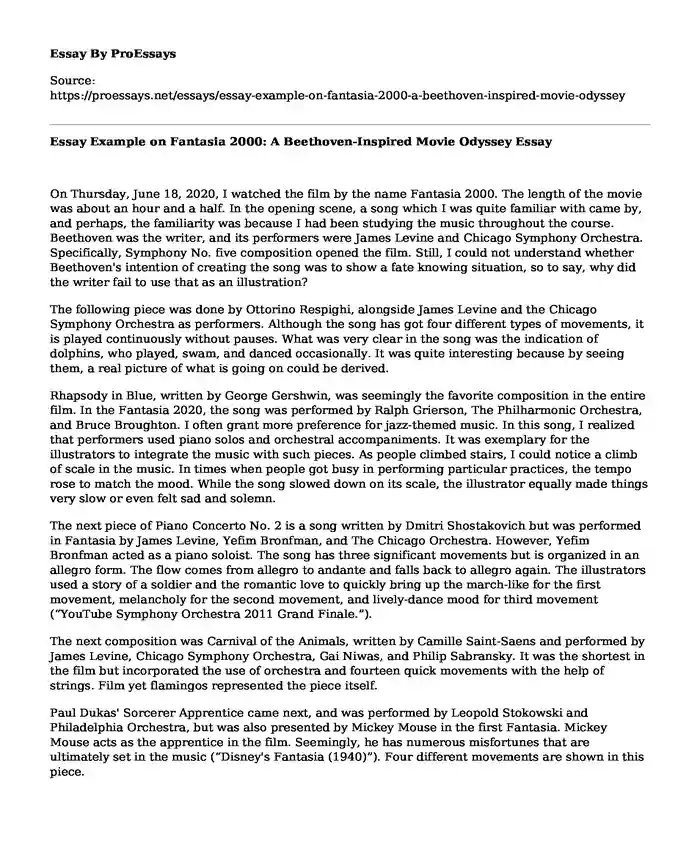On Thursday, June 18, 2020, I watched the film by the name Fantasia 2000. The length of the movie was about an hour and a half. In the opening scene, a song which I was quite familiar with came by, and perhaps, the familiarity was because I had been studying the music throughout the course. Beethoven was the writer, and its performers were James Levine and Chicago Symphony Orchestra. Specifically, Symphony No. five composition opened the film. Still, I could not understand whether Beethoven's intention of creating the song was to show a fate knowing situation, so to say, why did the writer fail to use that as an illustration?
The following piece was done by Ottorino Respighi, alongside James Levine and the Chicago Symphony Orchestra as performers. Although the song has got four different types of movements, it is played continuously without pauses. What was very clear in the song was the indication of dolphins, who played, swam, and danced occasionally. It was quite interesting because by seeing them, a real picture of what is going on could be derived.
Rhapsody in Blue, written by George Gershwin, was seemingly the favorite composition in the entire film. In the Fantasia 2020, the song was performed by Ralph Grierson, The Philharmonic Orchestra, and Bruce Broughton. I often grant more preference for jazz-themed music. In this song, I realized that performers used piano solos and orchestral accompaniments. It was exemplary for the illustrators to integrate the music with such pieces. As people climbed stairs, I could notice a climb of scale in the music. In times when people got busy in performing particular practices, the tempo rose to match the mood. While the song slowed down on its scale, the illustrator equally made things very slow or even felt sad and solemn.
The next piece of Piano Concerto No. 2 is a song written by Dmitri Shostakovich but was performed in Fantasia by James Levine, Yefim Bronfman, and The Chicago Orchestra. However, Yefim Bronfman acted as a piano soloist. The song has three significant movements but is organized in an allegro form. The flow comes from allegro to andante and falls back to allegro again. The illustrators used a story of a soldier and the romantic love to quickly bring up the march-like for the first movement, melancholy for the second movement, and lively-dance mood for third movement (“YouTube Symphony Orchestra 2011 Grand Finale.”).
The next composition was Carnival of the Animals, written by Camille Saint-Saens and performed by James Levine, Chicago Symphony Orchestra, Gai Niwas, and Philip Sabransky. It was the shortest in the film but incorporated the use of orchestra and fourteen quick movements with the help of strings. Film yet flamingos represented the piece itself.
Paul Dukas' Sorcerer Apprentice came next, and was performed by Leopold Stokowski and Philadelphia Orchestra, but was also presented by Mickey Mouse in the first Fantasia. Mickey Mouse acts as the apprentice in the film. Seemingly, he has numerous misfortunes that are ultimately set in the music (“Disney's Fantasia (1940)”). Four different movements are shown in this piece.
The following song, known as Pomp and Circumstance, was done by Donald Duck. However, the Disney Classic postulated that this match-type composition would coincide with a Noah’s Ark. The piece perfectly matches with number 1,2,4 and 4 song written by Edward Elgar, which appears in the subsequent piece. Although we tend to believe that Elgar's work was meant for graduation, this piece can be applicable in several solemn events. In Fantasia 2000, it was performed by Chicago Symphony Chorus, Chicago Symphony Orchestra, James Levine, and Kathleen Battle. Accurately, match #1 opening is strong with a rising note, match #2 comes as the shortest of all matches, while match #3 appears different from a solemn mood. The last match #4 shows an upbeat, and it is also ceremonial.
Conclusion
Finally was the Firebird Suite that was written by Igor Stravinsky and performed by James Levine and Chicago Symphony Orchestra. In its first scene, there is a repetition of a melody that tends to change dynamics, the tone color, and its rhythm as well. In the second scene, an increase in the music sound is noted as the buildup becomes stronger. This is imminently followed by a tranquil part that formulates to a quick crescendo, and eventually, its climax. In a nutshell, this Disney piece attempts to symbolize life, death, and the overall renewal. All these were used by performers to illustrate the piece beautifully.
Works Cited
“YouTube Symphony Orchestra 2011 Grand Finale.” YouTube, uploaded by YouTube Symphony Orchestra, 21 May 2011, https://youtu.be/LnKJpYGCLsg
“Disney's Fantasia (1940).” YouTube, uploaded by Disney Dynasty, 27 June 2014, https://youtu.be/r7gLlIv4ito
Cite this page
Essay Example on Fantasia 2000: A Beethoven-Inspired Movie Odyssey. (2023, Sep 10). Retrieved from https://proessays.net/essays/essay-example-on-fantasia-2000-a-beethoven-inspired-movie-odyssey
If you are the original author of this essay and no longer wish to have it published on the ProEssays website, please click below to request its removal:
- Venus of Urbino by Titian and Other Paintings Analysis
- Three Worst Types of Students Essay
- The Relationship Between Graduate Attributes and Employability Essay
- The Symbolism of Color in Sir Gawain and the Green Knight Essay
- The Literature of Salsa Dance Essay
- SOS: Preparing High School Graduates for College Life and Career Choice - Essay Sample
- Paper Example on Understanding Williams Syndrome: Causes, Symptoms & Treatment







